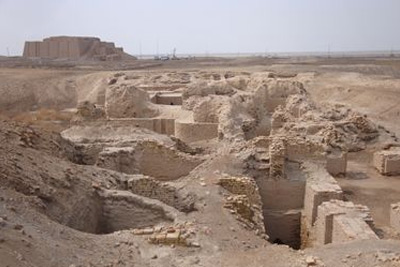Sumeria had millions of sheep and a large agricultural surplus, due to all the irrigation canals. The area was very poor in stone, metals and wood, and these all had to be imported from far away. The largest trading areas for Sumeria was the Persian Gulf (particularly todays Bahrain, Oman, UAE, Pakistan and India), Anatolia (Turkey) and the Zagros Mountains area in Iran. For the trade with the Persian Gulf, typically Sumerians traded with Magan (Oman/UAE) and Dilmun (Bahrain) and they again traded further away. The Ur trade seems to have been driven mainly by institutional actors (like the temples).

Ur
Ur (𒌶𒆠) was founded around 3800 BCE, during the Ubaid period. It was considered a city-state from the 26th century BCE, with Mesannepada its first recorded king.

Read more about Nanna/Sin/Suen, the moon god.
The most spectacular royal graves in the Royal Cemetery of Ur were Private Grave 800, belonging to a richly adorned queen identified as Puabi or Pu-abum, Private Grave 1054, with an unidentified female, Private Grave 789, called the King's Grave, and Private Grave 1237, the Great Death Pit. The Private Grave 789 had been the target of grave robbers, but its death pit contained the bodies of 63 servants or retainers. Private Grave 1237 held 74 servants or retainers (many of them were elaborately dressed women arranged around a set of musical instruments).
It is currently believed (Baadsgaard and colleagues) that these servants or retainers were killed by blunt force trauma, possibly as ritual sacrifices. After they were killed, an attempt was made to preserve the bodies, using a combination of heat treatment and the application of mercury; and then the bodies were dressed in their finery and laid in rows in the pits.
See a complete list of Ur kings.
Buildings in Ur used all the basic forms of architecture (the column, the vault, the dome and the arch. In addition, the construction of the main ziggurat showed a sophisticated understanding of entasis, with all walls sloped and curved to give the viewer a better sense of proportion when looking at the large structure.
The current site of Ur is Tell el-Muqayyar or Tall al-Muqayyar (Arabic: تل المقير) in south Iraq's Dhi Qar Governorate, about 16 km west of the present bed of the Euphrates River. The current site is about one square kilometre, dominated by the remains of the Ziggurat of Ur (much of this ziggurat has been rebuilt in the last 50 years).
Interesting articles
You may also be interested in these articles

Trees in Sumeria
It is easy to think of Sumeria as a barren land, only kept alive by irrigation canals. In addition to irrigated trees such as date palms, we also find interesting flora such as the tamarisk, juniper and cedar.

The Lion Hunt
If you have visited the Sumerian section of the British Museum, chances are you have seen the Lion Hunt of Ashurbanipal. It is a series of very impressive wall coverings illustrating the King Ashurbanipal's prowess.

The game of Ur
Possibly the oldest board game in existence, and surely the oldest we have rules for, the Game of Ur is a fascinating predecessor to Backgammon. Watch a video on how to play it, and see the original at British Museum.






